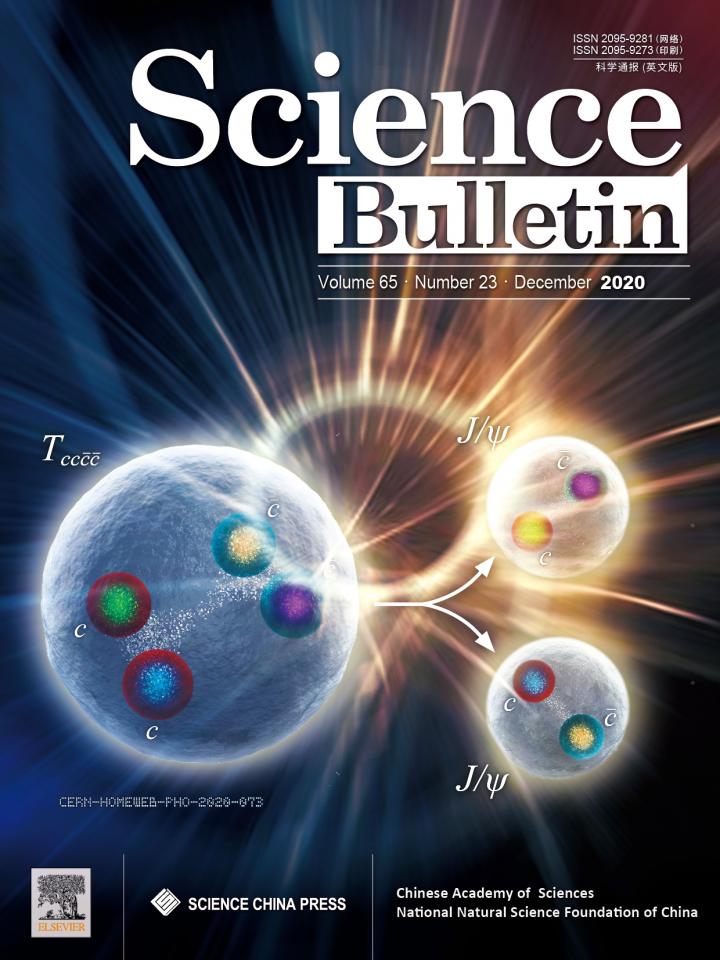
Credit: ©Science China Press
The strong interaction is one of the fundamental forces of nature, which binds quarks into hadrons such as the proton and the neutron, the building blocks of atoms. According to the quark model, hadrons can be formed by two or three quarks, called mesons and baryons respectively and collectively referred to as conventional hadrons. The quark model also allows for the existence of so-called exotic hadrons, composed by four (tetraquarks), five (pentaquarks) or more quarks. A rich spectrum of exotic hadrons is expected just as for the conventional ones. However, no unambiguous signal of exotic hadron was observed until 2003, when the X(3872) state was discovered by the Belle experiment. In the following years, a few more exotic states were discovered. The explanation of their properties requires the existence of four constituent quarks. Identification of pentaquark states is even more difficult, and the first candidates were observed by the LHCb experiment in 2015. All these known states contain at most two heavy quarks, the beauty or charm quark.
Recently, by studying the invariant mass distribution of two J/? mesons produced in proton-proton collisions at center-of-mass energies up to 13 TeV, the LHCb collaboration observed two structures. The narrower structure is described as a hadron state of mass about 6900 MeV/c2, denoted as X(6900). As the J/? meson contains a charm (c) and an anticharm quark (bar{c}), the new state suggests a minimal quark content of ccbar{c}bar{c}, making it a candidate of four-charm tetraquark states. The other structure, being broad and close to twice the J/? rest mass, can be due to another tetraquark of larger width or a combination of several overlapping tetraquark states.
“It is very exciting to see the first experimental evidence of a four-charm tetraquark. The unique composition of the new state makes it an ideal laboratory to gain insight into the strong interaction inside hadrons,” says the LHCb physicist working at the INFN section of Florence, Liupan An.
While the quantum chromodynamics (QCD) is the commonly used theory to describe the strong interaction, understanding of the internal structure of a hadron is not yet possible from first-principle calculations. Models that approximate QCD are introduced to explain the binding mechanism of quarks into hadrons. In the molecular picture, an exotic state is formed by two weakly bound conventional hadrons like the deuteron. The molecular structure is currently the favoured interpretation of the narrow pentaquarks observed by LHCb and the X(3872) state. However, hadronic states made solely from heavy quarks are expected to be tightly bounded, for example, a four-charm tetraquark is usually considered to be formed by a cc-diquark and abar{c}bar{c}-antidiquark attracting each other. The cc-diquark model successfully predicted the mass of the Ξcc++ baryon observed by LHCb in 2017. Rescattering of known hadrons through the strong interaction is also possible to create structures that look like a hadron state. The nature of the newly observed four-charm states is yet to be determined even though a compact tetraquark interpretation is preferred.
“The LHCb observation opens a new window for studies of multiquark hadron spectroscopy. More studies from both experimental and theoretical physicists will provide the opportunity to understand the nature of the four-charm state,” says Yanxi Zhang, working on the LHCb experiment at the Peking University.
“If the four-heavy-quark interpretation is correct, a full spectrum of these tightly bound states is expected to be discovered from the data that LHCb will be able to collect in the near future. Measurements of the masses and widths of these states, which can be predicted in QCD with relatively high precision, will provide a probing test of our understanding of the fundamental interactions between hadrons.” adds Giacomo Graziani from INFN Florence.
LHCb is one of the four big experiments located at the most powerful particle accelerator in the world, the Larger Hadron Collider (LHC) at CERN. The LHCb experiment is dedicated to precision measurements of particles containing charm or beauty quarks, aiming at exploring the matter-antimatter asymmetry puzzle, looking for indirect evidence of new physics, and probing the strong interaction. The collaboration consists of more than 1400 physicists and engineers from all over the world.
“This is an important step forward in exploring the internal structure and dynamics of hadrons.” said Prof. Yuanning Gao, leader of the Chinese LHCb group, “The LHCb experiment has again demonstrated its capability in heavy flavour spectroscopy, and will continue contributing to the understanding of the strong interaction.”
The strong interaction keeps surprising us with new structures and new phenomena after several decades of questing and will surely do it again in the future.
###
See the article:
LHCb collaboration. Observation of structure in the J/ψ-pair mass spectrum. Science Bulletin, 2020, 65(23)1983-1993
https:/
http://engine.
Media Contact
Bei Yan
[email protected]
Related Journal Article
http://dx.




